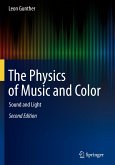This undergraduate textbook aids readers in studying music and color, which involve nearly the entire gamut of the fundamental laws of classical as well as atomic physics. The objective bases for these two subjects are, respectively, sound and light. Their corresponding underlying physical principles overlap greatly: Both music and color are manifestations of wave phenomena. As a result, commonalities exist as to the production, transmission, and detection of sound and light. Whereas traditional introductory physics textbooks are styled so that the basic principles are introduced first and are then applied, this book is based on a motivational approach: It introduces a subject with a set of related phenomena, challenging readers by calling for a physical basis for what is observed.
A novel topic in the first edition and this second edition is a non-mathematical study of electric and magnetic fields and how they provide the basis for the propagation of electromagnetic waves, of light in particular. The book provides details for the calculation of color coordinates and luminosity from the spectral intensity of a beam of light as well as the relationship between these coordinates and the color coordinates of a color monitor.
The second edition contains corrections to the first edition, the addition of more than ten new topics, new color figures, as well as more than forty new sample problems and end-of-chapter problems. The most notable additional topics are: the identification of two distinct spectral intensities and how they are related, beats in the sound from a Tibetan bell, AM and FM radio, the spectrogram, the short-time Fourier transform and its relation to the perception of a changing pitch, a detailed analysis of the transmittance of polarized light by a Polaroid sheet, brightness and luminosity, and the mysterious behavior of the photon.
The Physics of Music and Color is written at a level suitable for college students without any scientific background, requiring only simple algebra and a passing familiarity with trigonometry. The numerous problems at the end of each chapter help the reader to fully grasp the subject.
A novel topic in the first edition and this second edition is a non-mathematical study of electric and magnetic fields and how they provide the basis for the propagation of electromagnetic waves, of light in particular. The book provides details for the calculation of color coordinates and luminosity from the spectral intensity of a beam of light as well as the relationship between these coordinates and the color coordinates of a color monitor.
The second edition contains corrections to the first edition, the addition of more than ten new topics, new color figures, as well as more than forty new sample problems and end-of-chapter problems. The most notable additional topics are: the identification of two distinct spectral intensities and how they are related, beats in the sound from a Tibetan bell, AM and FM radio, the spectrogram, the short-time Fourier transform and its relation to the perception of a changing pitch, a detailed analysis of the transmittance of polarized light by a Polaroid sheet, brightness and luminosity, and the mysterious behavior of the photon.
The Physics of Music and Color is written at a level suitable for college students without any scientific background, requiring only simple algebra and a passing familiarity with trigonometry. The numerous problems at the end of each chapter help the reader to fully grasp the subject.








